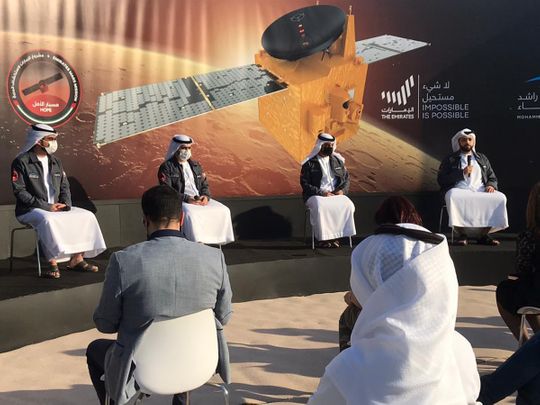
Dubai: Members of the Emirates Mars Mission (EMM) are confident Hope Probe will make a successful interaction with the Red Planet, but they are also getting ready for the 11-minute one-way signal delay during the critical Mars orbit insertion (MOI) on February 9. Hope Probe is scheduled to enter Mars orbit at 7.42pm (UAE time), but the actual insertion will happen around 7.31pm because of the 11-minute delay in communication between the Mars-bound spacecraft and Mohammed bin Rashid Space Centre (MBRSC) in Dubai.
“There is an 11-minute communication delay between the mission control and Hope Probe due to the vast distance between Earth and Mars,” Hamad Eisa Al Hazami, Hope Probe software development engineer and flight director, explained to Gulf News during a press briefing at MBRSC on Thursday.
“The total communication delay is 22 minutes. The first signal delay, which we call one-way light time (the elapsed time it takes for radio signal to travel between Earth and a celestial object), is the sending of command to Hope Probe from the ground control room. The second signal delay or two-way light time is another 11 minutes, when receive at MBRSC the response from the spacecraft,” Al Hazami added. “So, Hope Probe will enter Mars orbit around 7.31pm, but we will only know if it was successful around 7.42pm,” he said.
Occultation period
Another concern is when Hope Probe enters Mars orbit, it will hide behind the planet for about 15-20 minutes, causing all radio signals to be temporarily disconnected. This is called the occultation period, an event that occurs when an object or spacecraft is hidden by another object (or planet) that passes between it and the observer.
Al Hazami said they are prepared for any contingency. There is also no need to send live commands to Hope Probe as every detail has been pre-programmed even before Hope Probe went into deep space. The program has also been calibrated and modified several times using FlatSat, a large motherboard where modules are installed to test the instruments, telemetry database, properties and health of Hope Probe.
Autonomous orbit insertion
There is no do-over for the MOI that has a 50 per cent success rate. Hope Probe will enter Mars autonomously by firing its six Delta V thrusters to rapidly reduce the speed of the spacecraft from 121,000km/hr to 18,000km/hr before entering Mars orbit. Delta V is the change in velocity, where the spacecraft will fire its thrusters and burn fuel to produce a reaction force to decelerate. If one pair will malfunction, the two pairs will fire up and increase burning fuel to achieve the required deceleration.
Hope Probe’s success will make the UAE only the fifth country or entity in the world to reach Mars and the third country to achieve the feat on its first attempt.
24-hour monitoring team
The EMM ground crew are working on two shifts 24 hours daily, said Zakareyya Hussain Al Shamsi, deputy project manager — Mission Operations. “The first team are operators in charge of sending command and receiving telemetries (data from Hope Probe). The second team is composed of programmers doing scripts and testing on the ground using simulator satellites. The third is navigation team looking after the direction and path of Hope Probe and the last is the software and team of analysts,” he said.
Read more
- This is how Emirati engineers are preparing for Hope Probe arrival in Mars
- UAE launches ‘Professional Programme for Designing the Future 2071’ to understand future challenges
- Watch: Emirati engineers begin assembly of MBZ-SAT in Dubai
- Hope Probe arrival in Mars: UAE leaders given updates on historic mission
Al Shamsi said the ground station at MBRSC comprises young Emirati engineers, programmers and analysts all under 35 years are ready and prepared. “We have worked very hard. Yes, a lot of previous missions have failed — success rate is just 50 per cent — but that did not make us afraid. We will achieve this important milestone (in UAE’s space programme history),” added Al Shamsi with confidence.
‘Sit back and relax’
When asked what they will do during the 11-minuted waiting period, Al Hazami said: “We will monitor all the data, but we will also sit back, relax and wait for the good news.”








